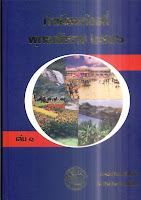But by random check of websites of subdistrict (Tambon) administrative organizations, I came across one case where a renumbering did take place recently. Bang Kaeo (บางแก้ว), Ban Laem district, Phetchaburi province is subdivided into eight villages, which according to the TAO website have the following names.
| หมู่ที่ | Name | English name |
| 1 | บ้านบางแก้ว | Ban Bang Kaeo |
| 2 | บ้านนาแค | Ban Na Khae |
| 3 | บ้านทำเนียบ | Ban Tham Niap |
| 4 | บ้านบนดอน | Ban Bon Don |
| 5 | บ้านหนองแห้ว | Ban Nong Haeo |
| 6 | บ้านนาบัว | Ban Na Bua |
| 7 | บ้านร่องใหญ่ | Ban Rong Yai |
| 8 | บ้านเหมืองกลาง | Ban Mueang Klang |
But - looking back at the 2002 Royal Gazette announcement with which the creation of village 7 and 8 was made official, the following section is found.
แยกหมู่บ้านเหมืองกลาง หมู่ที่ ๑ ตำบลบางแก้ว จัดตั้งเป็นหมู่บ้านใหม่อีก ๑ หมู่บ้าน ชื่อหมู่บ้านบางแก้ว โดยตั้งเป็นหมู่ที่ ๘ ตำบลบางแก้ว และให้มี อาณาเขต ดังนีTranslated, this means that Ban Mueang Klang Mu 1 of Tambon Bang Kaeo is split and one new village is created named Ban Bang Kaeo Mu 8 of Tambon Bang Kaeo. This is probably no mistake in the announcement, as ThaiTambon also confirms these names.
Thus, the names of village 1 and 8 have been changed between 2002 and 2009. Either, they really exchanged the names of the two Muban, or the numbers of the Muban have been exchanged but the names still refer to the same area as they did in 2002.
Needless to say that my inquiry on this issue at the TAO was left unanswered...







